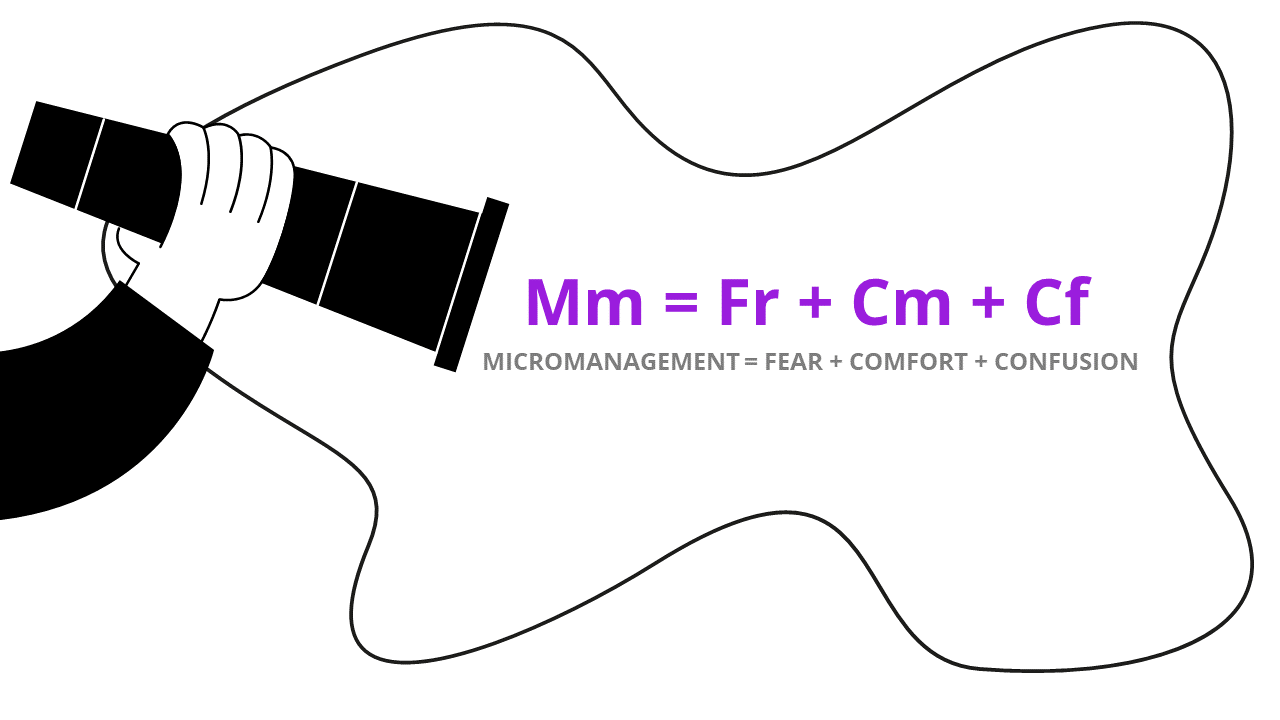
Micromanagement can turn your company into a toxic workplace that good employees abandon. Most leaders realize this, but few take proactive action towards addressing this issue. What’s worse, is that oftentimes we don’t see the glaring red flags signaling our micromanagement tendencies or fail to acknowledge the negative ripple effect of such behavior.
Just how bad is micromanagement? Let’s dig deeper into the matter together.
What is Micromanagement?
Micromanagement is a negative managerial practice where a team leader provides unnecessarily close supervision and directives to members of their team.
The majority of workplace psychologists agree that it is rather toxic behavior that builds up tension, diminishes employee morale, autonomy and productivity. In fact, according to a LinkedIn survey, employees named “micromanagement” as second among the most annoying qualities of a boss.
Below are some common examples of micromanaging that you might relate to (or recognize among your behaviors):
- Managers who refuse to delegate because they are sure they could do the work better and more efficiently.
- Supervisors who monitor and control employee communication and movement beyond what is standard for a professional environment.
- Team leaders who become frustrated when team members don’t complete tasks exactly in the way they personally would.
- A team leader who spends more time focusing on methodologies than results.
Why Micromanaging is Bad
Micromanaging creates an environment where employees do not feel trusted and aren’t able to use their skills productively. Micromanaged employees don’t feel permitted to show initiative, and they become highly disengaged in whatever they do. Their inability to control their work processes or make important decisions of their own ultimately builds up to complete indifference, low morale and lack of any active contributions. Ultimately, this directly reflects on the business bottom line. Research suggests that such lack of engagement and low initiative is costing companies in the United States up to $550 billion a year.

Ultimately, the constantly pressured and “over-managed” employees quit. A workplace survey mentioned in the book My Way or The Highway indicates that:
- A third of employees changed jobs because they were being micromanaged.
- 62% had seriously considered switching careers.
- Another 73% mentioned that micromanaging interfered with their ability to do their job.
Ultimately, the biggest problem with micromanagers is that through their daily actions they are telling their subordinates that they do not have any confidence in their abilities, and believe them to be fundamentally incompetent. With that feedback, most workers will eventually fulfill that prophecy. Others will simply leave in favor of a workplace that doesn’t have micromanagement issues.
6 Signs That You Micromanage Too Much
- Do you insist on controlling how things are done, and which methodologies are acceptable?
- Are you inserting needless or excessive requirements for employees to obtain approvals?
- And what about exerting dominance and control over how employees spend their work (and break) time?
- Are you engaging in excessive monitoring and reporting?
- Do you find yourself performing the work that should be done by others?
- Are you struggling with collaborations and prefer to get things done by yourself instead?
If you gave a quick nod to at least one of these questions, well, you probably need to address some problems in your management style.
Other Negative Types of Management Styles to Avoid
Micromanaging isn’t the only negative management trait to watch out for. Several other problematic styles often build up workplace tension and sabotage team productivity.
Seagull Management
In a sense, seagull management is the opposite of micromanagement. While a micromanager is needlessly involved in every detail, giving employees little to no autonomy, the seagull manager is completely hands-off. At least, they are at first. They leave employees alone giving little feedback or praise.
Unfortunately, this stops when there is a perceived problem. Then, the manager ‘flies in’ like a seagull. Of course, they rarely have useful insights into the problem. Instead, they berate, blame, and criticize. They also latch onto these problems as a way to draw attention to themselves and their ‘heroism’ for swooping in to save the problem.
Overparenting
Overparenting is the act of obsessively removing roadblocks for your employees and leaving them with little opportunity to solve their own problems. As you might expect, over-parented workers lose out on the ability to develop new skills through problem-solving. They often have a reduced ability to handle conflicts or assess risks as well.
Narcissistic Leadership
Narcissistic leadership is the management style of choice of leaders who only care about themselves. Interestingly enough, while the term does carry a negative connotation, not all narcissistic leaders are harmful.
A healthy narcissist recognizes the value of providing praise to employees and understands that when their teams succeed so do they. It is the toxic narcissists that will seek power by undercutting others and backbiting, and who don’t see the value of treating others well. Still, it’s important to be aware of any tendencies you might have towards narcissism. Of course, recognition is an important first step, but you must also take action.
How to Tame Your Micromanagement Tendencies
Let’s be honest: all of us have certain micromanagement issues. Learning to recognize and acknowledge them is the first step towards becoming a better leader.
So let’s take a closer look at why people micromanage. Harry Chambers, the author of the aforementioned My Way or The Highway book, explains this tendency with the following formula:
Micromanagement = Fear + Comfort + Confusion.

The concept of fear is pretty easy to understand. Managers often fear that their employees will fail, and that will reflect poorly on them. This fear creates the impression that the manager lacks confidence in their team.
Comfort reflects the manager’s own comfort levels. They may simply be uncomfortable with giving their team members as much autonomy as they should.
Finally, confusion is the result of failure to communicate expectations, to define the parameters of success, or otherwise foster mutual understanding. This often leaves workers unsure of what to do, or what their roles are. They may do nothing, as they feel a bit paralyzed. When this happens, managers may feel the need to rush in and fill in the gaps by doing the work themselves. What they should be doing is providing clearer instructions and better training.
Below are some additional tips showing you how to not micromanage your team (but still keep an eye on their performance and provide help when it’s truly needed!).
1. Communicate With Workers and Give Them Autonomy
A good leader will allow workers as much autonomy as their abilities and performance allow. Further, try to adapt your management style to the work styles of each team member. A lagging team member may appreciate more frequent check-ins and some “coaching”. An experienced pro who loves going solo, on the contrary, would feel unwanted attention. To avoid such scenarios, ask each team member directly which management styles work best for them, and what motivates them. Then, do your best to honor their requests and jump in only when your help’s requested.
Helpful template: Manager vs Leader PowerPoint Template
2. Find Ways to Satisfy Your Need For Communication Without Making Unreasonable Demands
Next, adjust your project management methods. Think about how you can gain some reassurance about the project progress without taxing your workers with over-communication and over-reporting. Below are several examples:
- Schedule a weekly status update session with each team member instead of hovering around their desks, or sending dozens of emails each week.
- Ask your team to fill in a Gantt chart every week to showcase what they are working on.
- Run a team availability report that would immediately tell you how much work each team member already has on their plate.
Helpful template: Editable Gantt Chart for PowerPoint
3. Give Employees More Tools Than Commands
Finally, adopt the role of facilitator, not taskmaster. Tell employees what needs to be accomplished, ensure they have the resources to do that, and give them the autonomy to determine how they will accomplish that. Make sure they feel comfortable communicating their needs to you.
Helpful template: Business Progress Report Slides for PowerPoint
How to Deal With a Micromanager (If You are Pressured by One)
Unfortunately, the amount of power you have to change someone’s leadership style depends on your relationship with them, and where they are in the management structure vs. you.
For example, if an underling is guilty of micromanaging, training and mentoring can help. If you sense their micromanaging is fear-motivated, you can provide them with an assurance that they are working within a supportive environment.
If you are dealing with micromanagement issues from someone in a lateral position, that can be tricky. Nobody wants to create bad blood with other teams. However, the well-being of your team is a priority. In this case, setting boundaries, and sticking up for your employees is a good thing. Sometimes, these issues can be resolved with communication to uncover the reasons behind the micromanaging tendencies.
The last part can be a bit sticky. How do you deal with a micromanager who has authority over you in the workplace? There are a few things you can do that could be reassuring enough to loosen the reins.
- First, come up with a written agreement regarding how and when you will communicate progress on projects.
- Next, ask directly what it will take for your boss to loosen their grip on you and your team. Communicate honestly about how their management style is impeding performance.
- Finally, be willing to take an objective look at your team’s performance, and acknowledge any shortcomings.
Conclusion
Now you know why micromanaging is bad and what other managerial styles to avoid. Your next step is to get more proactive with recognizing your tendencies (or addressing such displayed by someone else on your team) and make the necessary adjustments. Remember: fixing your managerial style is easier (and less costly) than having good people quit.


